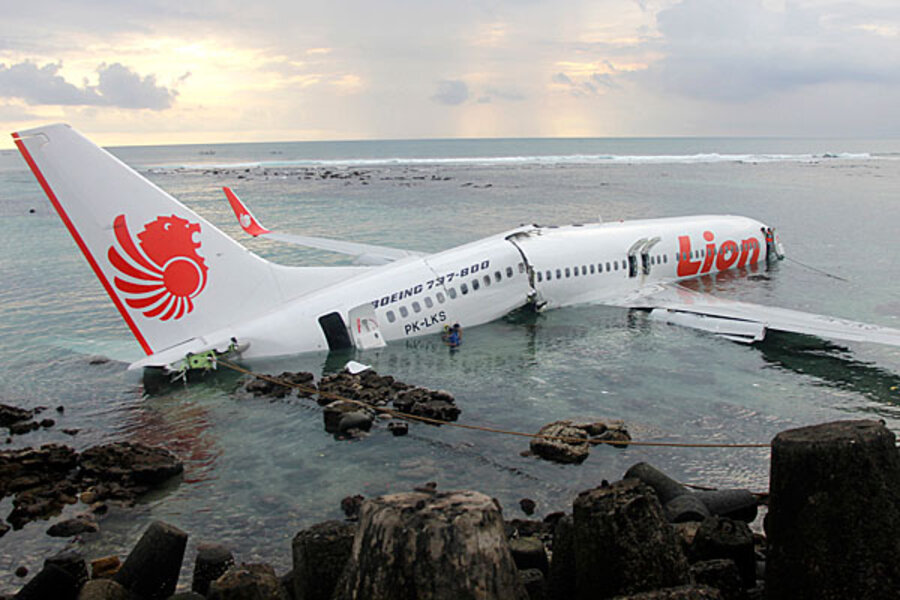Airplane crashes in water off Bali, no fatalities
Loading...
Everyone on board survived when a new Boeing 737-800 aircraft landed in the water just short of the runway in Bali, Indonesia.
All 101 passengers and seven crew members aboard a Lion Air flight were rescued Saturday within minutes of the crash. Some 45 people have been taken to local hospitals with injuries, but none seemed life threatening, according to one Indonesian airport official.
Initial reports said the aircraft had overshot the runway. But a Lion Air spokesman, Edward Sirait, told reporters that the plane did not reach the runway, it hit the water first.
Three of the passengers aboard were foreigners, two Singaporeans and a French national, according to The Associated Press. The rest of those on board were Indonesians on a domestic flight that originated in Bandung, West Java. The flight had stopped at two other cities prior to the crash on Bali.
After the crash, evacuation and rescue efforts proceeded quickly, according to eyewitness accounts. An Australian surfer told The Sydney Morning Herald that the aircraft came down in shallow water about 300 yards from where he was paddling. By the time he joined the rescue effort, about five minutes later, he said that most of the passengers were on the wing or climbing onto rocks. He helped one man to shore on his surfboard.
The aircraft involved was a new Boeing 737-800, a popular design in use worldwide. A total of 4,293 of the 737 Next Generation aircraft (including the 737-600, -700-, -800, and -900ER models) have been delivered by the end of December 2012, according to Boeing.
Boeing boasts that the 737-800 is the best-selling aircraft in the Next Generation series (with more than 2,800 in operation and more than 4,000 ordered). Boeing says that the aircraft is "known for its reliability, fuel efficiency and economical performance, the 737-800 is selected by leading carriers throughout the world because it provides operators the flexibility to serve a wide range of markets. The single-aisle jet, which can seat between 162 to 189 passengers, can fly 260 nautical miles farther and consume 7 percent less fuel while carrying 12 more passengers than the competing model."
This was a new aircraft, only in operation since March, which should mean that aircraft mechanical reliability or age, shouldn't be an issue. But Lion Air spokesman Edward Sirait, hinted that the aircraft was the problem “When it tried to land at the airport, the aircraft was not able to reach the runway due to the incident," he said according to The Jakarta Post. The spokesman did not describe the nature of the incident. The pilot, said Sirait, had more than 10,000 hours of flying experience, but he didn't say in which types of aircraft.
So why did the aircraft crash-land short of the runway? It's too soon to say. Investigators will be looking at the black box, the data recorder, for information about the last minutes of the flight and will be questioning the flight crew. The weather was cloudy with a light rain at the time of the crash. There were no indications of thunderstorms or wind turbulence that might cause the plane to suddenly plummet just short of the runway.
In some cases in the past, when aircraft landed short of the runway, the causes were engine problems, and possible pilot error in response.
In 1989, a British Midland Airways Boeing 737-400 crashed short of the runway, killing 47 passengers. The two-engine aircraft had trouble in the No. 1 engine when a fan blade fractured, but the crew mistakenly shut down the No. 2 engine. The No. 1 engine continued operating, but upon approach to the airport, they lost that engine too. The accident report blamed the crash on the incorrect response by the flight crew to the malfunctioning No. 1 engine.
In 2008, a British Airways Boeing 777 crashed short of the runway at Heathrow after a 5,000-mile flight from Beijing, reported the BBC. The cause of the crash was later determined to be a loss of both engines due to a buildup of ice that restricted fuel flow, according to the UK Air Accidents Investigation Branch (AAIB). There were no fatalities in the crash. Boeing identified the problem as specific to the Rolls-Royce engine fuel-oil heat exchangers, and Rolls-Royce developed a modification that European authorities required to be made on Rolls-Royce engines by January 2011. Boeing noted that the 777 fitted with GE and Pratt & Whitney engines had not experienced similar problems.
Lion Air, a discount air carrier, started operating in 2000 and has rapidly expanded to become Indonesia's largest private commercial airline.
The Sydney Morning Herald reported that "Lion Air has had five crashes and major incidents in recent years. One of those crashes, in 2004, claimed the lives of 25 people. However its safety record has come under attack, with both the US and European Union banning the airline from its skies because it has failed to pass the required internationally recognized safety audit."
The airline had been sanctioned in January 2013 because some pilots and crew had been caught with crystal meth. "We have reprimanded the airline and revoked the license of the pilots and crew," the ministry's air transportation director general, Herry Bhakti Gumay, told The Jakarta Post.








